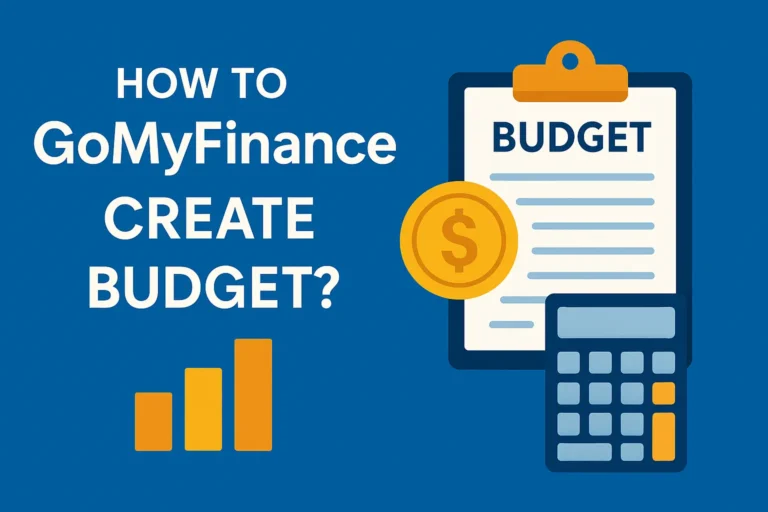GoMyFinance Saving Money: 15 Proven Strategies to Build Wealth in 2025
Saving money in 2025 feels like climbing a mountain with rising costs for groceries, utilities, and everything. You’re not alone if you’re stressed about making ends meet or building a nest egg. Many Americans are searching for practical ways to stretch their dollars further.
This guide from GoMyFinance Saving Money is your roadmap to smarter saving. You’ll learn 15 actionable strategies, from budgeting basics to cutting hidden costs, all tailored for beginners. Whether you’re aiming for an emergency fund or dreaming of financial freedom, we’ve got you covered with tips, tools, and real-life examples.
Why Gomyfinance Saving Money Matters in 2025?
Inflation’s still biting, and everyday expenses keep creeping up. According to the U.S. Bureau of Labor Statistics, consumer prices rose 3.2% in 2024, squeezing budgets nationwide. Saving money isn’t just about skipping lattes—it’s about securing your future.
GoMyFinance’s saving money tools make it easier. Their trackers and tips help you take control, whether you’re paying off debt or building wealth. Let’s dive into how you can start today.
Understand Your Financial Starting Point
Before you save a dime, you need to know where your money’s going. Think of it like checking your car’s GPS before a road trip—you can’t plan the route without knowing your starting point.
Assess Your Income, Expenses, and Debts
Grab a notebook or use a free app like GoMyFinance’s expense tracker. List your monthly income (salary, side hustles) and expenses (rent, groceries, subscriptions). Don’t forget debts—credit cards, student loans, or car payments. For example, Sarah, a 30-year-old teacher, found she was spending $200 monthly on unused apps after doing this exercise.
Tools to Visualize Your Financial Health
GoMyFinance offers free budgeting tools to map your cash flow. Their dashboard shows your spending patterns in colorful charts, making it easy to spot leaks. Apps like Mint or YNAB are also great for beginners.
Create a Realistic Budget That Works
A budget is your money’s best friend. It’s not about restriction—it’s about giving every dollar a job. Let’s break it down.
Step-by-Step Guide to Building a Budget
- Calculate your net income: That’s your take-home pay after taxes.
- List fixed expenses: Rent, utilities, insurance.
- Track variable expenses: Groceries, gas, entertainment.
- Set savings goals: Aim for at least 10% of your income.
- Review weekly: Adjust as needed to stay on track.
For example, Mike, a retail worker, used GoMyFinance to create a budget and saved $500 in three months by cutting impulse buys.
Popular Budgeting Methods
- 50/30/20 Rule: 50% needs (housing, bills), 30% wants (dining out), 20% savings/debt.
- Zero-Based Budget: Every dollar is assigned (bills, savings, fun).
- Envelope System: Use cash for categories like groceries to avoid overspending.
How to Track Expenses Effortlessly?
Apps make this a breeze. GoMyFinance’s tracker syncs with your bank, categorizing expenses automatically. Set alerts for overspending, like when you’re about to blow your coffee budget.
Set SMART Savings Goals
Saving without a goal is like driving without a destination. GoMyFinance saving money tips emphasize SMART goals: Specific, Measurable, Achievable, Relevant, Time-bound.
Define Short-Term and Long-Term Goals
- Short-term: Build a $1,000 emergency fund in 6 months.
- Long-term: Save $10,000 for a home down payment in 3 years.
For instance, Lisa, a nurse, set a goal to save $2,000 for a vacation. She broke it into $167 monthly chunks, making it feel doable.
Use the SMART Framework
- Specific: “Save $1,000” beats “save more.”
- Measurable: Track progress monthly.
- Achievable: Base it on your income.
- Relevant: Tie it to your dreams (e.g., debt freedom).
- Time-bound: Set a deadline, like December 2025.
Align Goals with Your Budget
Plug your savings goal into your budget. If you’re using the 50/30/20 rule, that 20% savings chunk should cover your SMART goal. GoMyFinance’s goal tracker sends reminders to keep you focused.
Automate Your Gomyfinance Saving Money for Effortless Growth
Saving manually is tough—life gets in the way. Automation is like setting your coffee maker the night before: it just happens.
Benefits of Automation
- Consistency: No skipping months.
- Discipline: You save before you spend.
- Growth: Even small amounts add up.
How to Set Up Automatic Transfers?
Log in to your bank or use GoMyFinance’s savings tool. Schedule a transfer (e.g., $50) to a savings account every payday. For example, John automated $100 monthly and saved $1,200 in a year without thinking about it.
Choosing the Right Savings Accounts
Look for high-yield savings accounts with at least 4% APY. Banks like Ally or Marcus offer these with no fees. GoMyFinance compares accounts, showing you rates and perks in one click.
Check out article: Ultimate Guide to Mastering Your Credit Score with GoMyFinance.com
Cut Costs Like a Pro: Practical Strategies
Saving big starts with trimming small expenses. Here’s how to slash costs without feeling deprived.
Reduce Food Expenses
- Meal plan: Spend $10 weekly planning dinners to avoid takeout.
- Buy in bulk: Stock up on rice or pasta at Costco.
- Eat out less: Limit restaurants to once a week.
Emma, a single mom, saved $150 monthly by packing lunches instead of buying them.
Lower Utility Bills
- Unplug devices: Save $10–$20 monthly on “vampire” energy.
- Use LED bulbs: They last longer and cut costs.
- Adjust thermostat: Lower it 2 degrees to save 5% on heating.
Minimize Transportation Costs
- Carpool: Split gas with coworkers.
- Use public transit: A $100 monthly pass beats $300 in gas/parking.
- Maintain your car: Regular tune-ups boost fuel efficiency.
Shop Smarter
- Use coupons: Apps like Honey find deals automatically.
- Buy second-hand: Thrift stores have great clothes for less.
- Wait for sales: Black Friday is perfect for big purchases.
Cancel Unused Subscriptions
Audit your bank statement. Cancel that $9.99 app you forgot about. GoMyFinance’s subscription tracker flags unused services, like when Tom ditched a $15 streaming service he barely used.
Tackle Debt to Free Up Cash
Debt’s like a leaky bucket—fix it to keep more money. Prioritize high-interest debt first.
Prioritize High-Interest Debt
Credit cards (18–25% APR) cost more than student loans (5–7%). Pay minimums on low-interest debts, then throw extra cash at high-interest ones.
Debt Repayment Strategies
- Snowball Method: Pay the smallest debts first for quick wins.
- Avalanche Method: Tackle the highest-interest debts to save more long-term.
For example, Rachel used the avalanche method to clear $5,000 in credit card debt, saving $600 in interest.
Avoid New Debt
- Shop with cash or a debit card.
- Pause credit card use for 30 days.
- Build an emergency fund to avoid borrowing.
Maximize GoMyFinance Saving Money with Rewards and Accounts
Turn everyday spending into savings with these hacks.
Leverage Cashback and Rewards
Use cards like Chase Freedom for 5% cashback on groceries. Apps like Rakuten give 1–10% back on online purchases. Maria earned $200 in rewards last year just by shopping smart.
Explore High-Yield Savings Accounts and CDs
High-yield accounts earn 10x more interest than regular ones. CDs lock your money for 1–5 years but offer higher rates. Here’s a quick comparison:
| Account Type | APY | Access | Best For |
| High-Yield Savings | 4–5% | Anytime | Emergency fund |
| 1-Year CD | 5% | After 1 year | Short-term goals |
| Regular Savings | 0.5% | Anytime | Low-priority |
Compare Savings Options
GoMyFinance’s comparison tool lists fees, rates, and minimums. Always check for no-fee accounts to keep more of your money.
Avoid Hidden Fees and Pitfalls
Small fees add up fast. Here’s how to dodge them.
Bank Fees, Late Payments, and ATM Charges
- Choose fee-free banks: Online banks like Chime have no monthly fees.
- Set payment reminders: Use GoMyFinance to avoid late penalties.
- Use in-network ATMs: Save $3–$5 per withdrawal.
Common Budgeting Mistakes
- Not tracking small purchases: $5 coffees add up to $150 monthly.
- Overestimating income: Base your budget on take-home pay.
- Ignoring irregular expenses: Save for car repairs or holidays.
Read more: Mastering Personal Finance with Go My Finance: Your Guide to Financial Freedom
Invest in Your Future for Long-Term Wealth
Saving is step one; investing is step two. Even small investments grow over time.
Basics of Low-Risk Investments
- Index Funds: Spread your money across stocks for steady growth (7–10% annually).
- Bonds: Safer, with 3–5% returns.
- Robo-Advisors: Platforms like Betterment invest for you with low fees.
For example, Alex invested $50 monthly in an index fund and had $7,000 after 10 years.
How Saving Fuel Saves Financial Freedom?
Every dollar saved today compounds. Start with $100 monthly in a high-yield account, and in 20 years, you could have $50,000 with interest. GoMyFinance’s investment calculator shows your potential growth.
Real Success Stories from GoMyFinance Saving Money Users
Real people, real results. Meet James, a barista who used GoMyFinance saving money tools to save $3,000 for a new laptop. He automated $75 monthly and cut dining out. Or take Priya, who paid off $10,000 in debt using the snowball method and GoMyFinance’s debt tracker. Their lesson? Small changes, big wins.
FAQs
How does GoMyFinance help me save?
GoMyFinance offers free trackers for budgeting, debt, and savings goals. Their tools sync with your bank, giving real-time insights to cut costs.
What’s the best budgeting method for beginners?
The 50/30/20 rule is simple: 50% needs, 30% wants, 20% savings/debt. It’s flexible and easy to stick with.
How do SMART goals improve GoMyFinance saving money?
SMART goals give clarity and deadlines, making saving feel achievable. Instead of “save more,” you aim for “$1,000 by June.”
How can I monitor spending effectively?
Use GoMyFinance or apps like Mint to track every dollar. Set weekly check-ins to catch overspending early.
Conclusion
Saving money in 2025 doesn’t have to be overwhelming. With GoMyFinance saving money tools, you can budget like a pro, cut costs, and build wealth. Start small—set a SMART goal, automate $25 monthly, and audit your subscriptions. Those steps alone could save you hundreds this year.
Ready to take control? Try GoMyFinance’s free tools today. Share your favorite tip in the comments or tell us your savings goals! Want more? Check out our guide on how to pay off debt faster.







